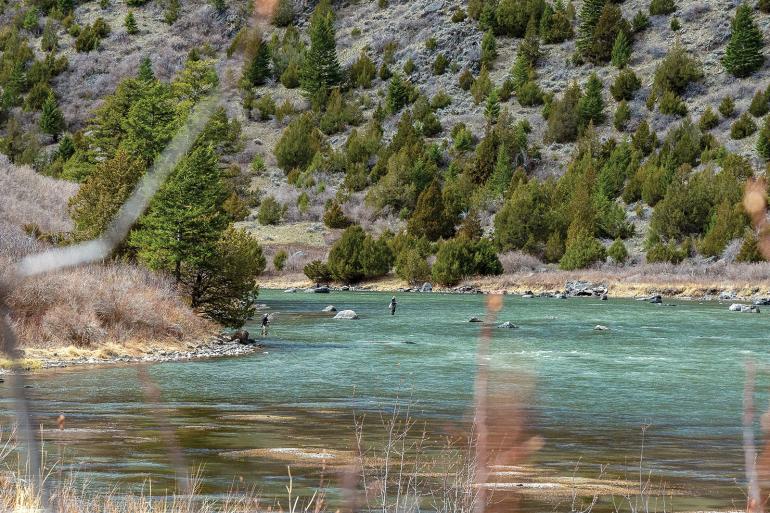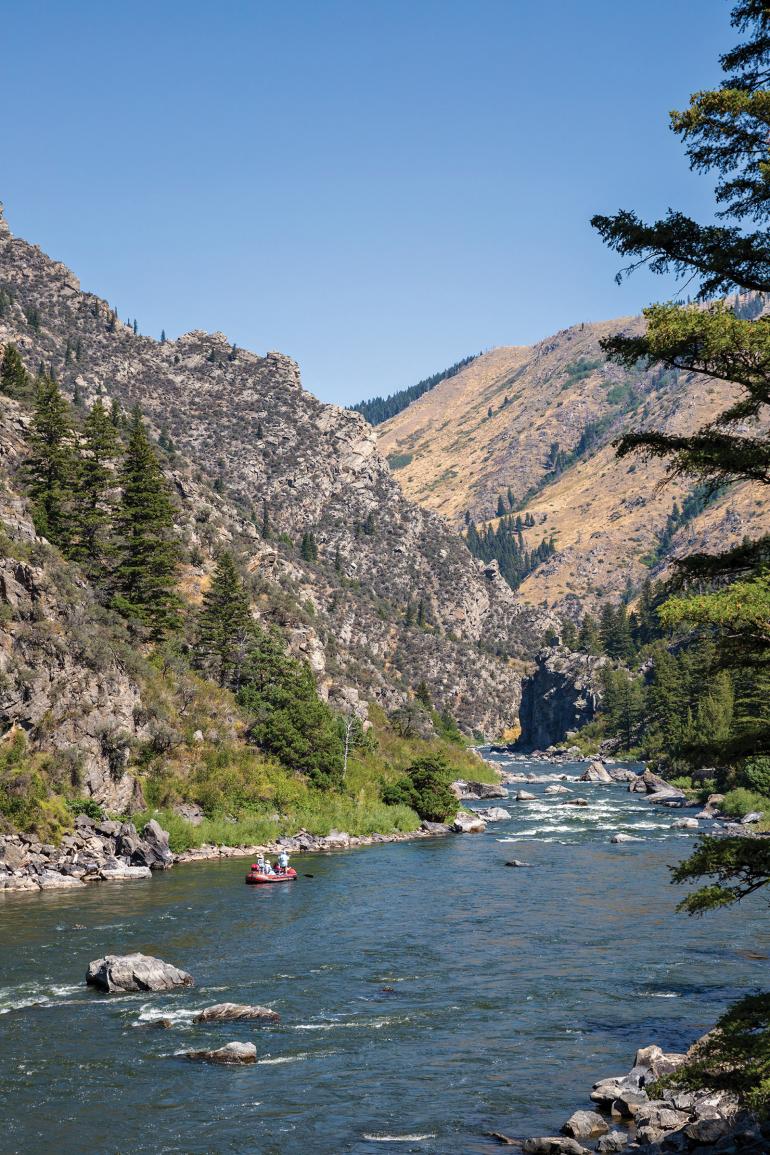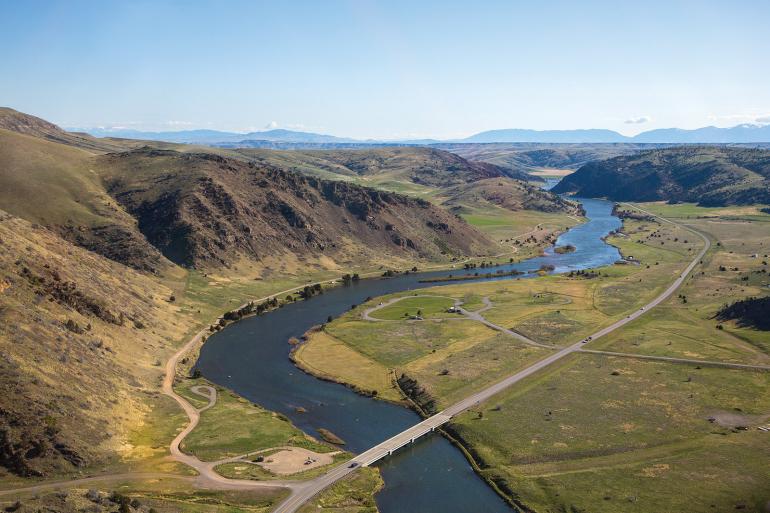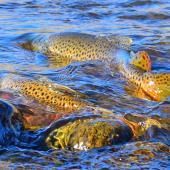Lower Madison: The People’s River
Fishing a close-to-town classic.
When it comes to the classic rivers in the state, the lower Madison makes the cut by a mile—by about 20 miles, actually. From Ennis Dam downstream to Warm Springs, the lower Madison cuts through vast sections of public land, making for easy access, a variety of water, and some of the best fishing in the state. It stays clear when other rivers are muck-brown, and can fish well deep into winter. Best of all, it’s just a hop, skip, and a jump from Bozeman.
Access
The lower Madison begins in the Lee Metcalf Wilderness Area, in a tract known as Bear Trap Canyon. There’s a single float-access point at the powerhouse just downstream of the Ennis Dam. From there, the river flows around eight miles to the Warm Springs Fishing Access Site. The canyon stretch is best left to experts on the oars, as it houses a few of the largest rapids in the state. But for those willing to put in their steps, hiking trails on both sides of the river provide plentiful access, and the ability to escape the crowds while working up the trail. Then, from Warm Springs down to Black’s Ford, numerous access sites parallel the river along Bear Trap Rd. and Hwy. 84. Much of the land in this section belongs to the BLM, allowing anglers to cover the entire stretch on foot. There are several boat ramps along the way, as well: California Corner, Canaday, and Damselfly make for a variety of put-in and take-out options. Finally, when the river hits Black’s Ford, it veers away from the highway and follows the highly-privatized Madison Road. Access, and fish, become more difficult to find as the river progresses toward Three Forks.
Flows
There really doesn’t seem to be a prime flow for the lower Madison. The key is consistency. When the flows are changing, the fishing can become challenging. Look for stable flows from 1,500-3,500cfs. Temperature is also a key variable on the river. The lower Madison is plagued by high temperatures in the summer, which are tough for angler and fish alike.
When to Go
The lower Madison is a shoulder- and off-season fishery. In the winter months, the fishing can be spectacular. Just keep an eye on the wind, as a lot of the warmer winter days come with a stiff, cool breeze. But when the wind lays down, the river can offer some of the best nymphing or dry-fly fishing in the area.
March, however, is when the river really turns on. The water starts to warm, and the fish put on the feed bag. At this time, nymphing will be your standard fare, but afternoon midge hatches can turn some heads as well. Then, as spring runoff approaches (usually sometime in late April or early May), the Madison continues to fish well. April brings the beginning of the blue-winged olives—the first mayflies of the season. A calm cloudy day can produce some of the best surface action of the spring.
As the water warms up a little more, we hit the lower Madison’s most coveted hatch: the Mother’s Day Caddis. Usually coinciding with the first 50-degree water of the year, the hatch provides trout with biomass of biblical proportions. If you can time things properly, it can be some of the best fishing of the year. Yes, it will be crowded, but there’s plenty of water for everyone.
Once runoff is in full swing, the lower Madison becomes the best local option in the Bozeman area. Thanks to the Ennis Dam, very few days per year, if any, are completely unfishable. The water does become dirty, but not chocolate milk like other area rivers. This is the time to bust out the big nymphs, streamers, and dries, and aim tightly to structure. During late May and early June, the pale morning duns keep the fish looking up, while crayfish and sculpins keep the larger trout well fed underneath. Around mid-June, just as the other area rivers are approaching prime flows and temperatures, the lower Madison wraps up its season. Water temperatures rise into the 70s and the fish are best left alone until the cool nights of fall arrive. This is a good time to pump up a float tube, grab a beverage, and enjoy the water.
Fish
The lower Madison is home to a resilient bunch of fish. They battle high water temperatures, high fishing pressure, and a plethora of tubers that don’t always take care of the river. Yet nature finds a way. Rainbow and brown trout make up the majority of the fish. However, mountain whitefish, westslope cutthroat trout, and the occasional brook trout all call the lower Madison home. The fish average a modest size, with 8- to 14-inch trout being the average. There are plenty of bigger fish, too, but as angling pressure rises, they are becoming increasingly tricky to fool. The water closer to Bear Trap harbors the majority of the bigger fish. With slightly cooler water, better dissolved oxygen content, and a tremendous amount of aquatic food, the area in and around the canyon enables fish to grow to substantial sizes.
Row vs. Wade
Bear Trap Canyon devours boats yearly, and is best left to professional paddlers and whitewater savants. However, those willing to put in the miles on foot will find some of the most secluded wade fishing in the area. As the river slows and widens below Warm Springs, the lower Madison becomes a gentle meandering stream. This is the perfect place to learn to row or practice your skills in a stress-free setting. For the wade angler, this portion of the lower Madison is a dream. The majority of the river is slow, shallow, and has a sandy or gravel bottom. This makes getting around a breeze. With plenty of parking space, nearly all the best runs and holes on the river are accessible without a watercraft. Overall, the seven miles between Warm Springs and Black’s Ford may be the most usable water in the state for float and wade anglers alike. Just don’t forget to call your shuttle before leaving town—cell reception is nearly nonexistent.
Below Black’s Ford, the river widens again. The shallow gravel water is difficult to navigate with a hard-side boat during low flows. Be ready to hop out and slide through the long shallow riffles in the lower stretches. Experienced lower-Madison anglers often opt for a shorter float, allowing for more time fishing in the deeper runs.
Regs
Keep an eye on temperatures and updated hoot-owl restrictions in the summer months, when high water temps force Montana Fish, Wildlife & Parks to shut down fishing. And, as always, check the agency’s website for specific regulations on tackle restrictions and keeping fish.
Getting There
Catch Hwy. 84 west out of Four Corners and keep driving—you can’t miss the river. Black’s Ford is the first access as you come down the hill into the valley floor. Follow the road upstream to access Bear Trap Canyon.
Jake Walbridge is the manager at Montana Troutfitters.













